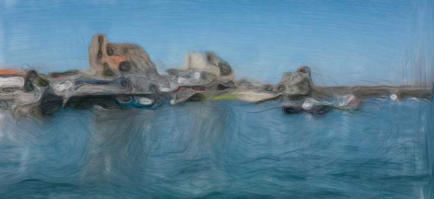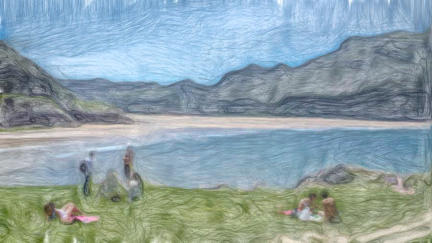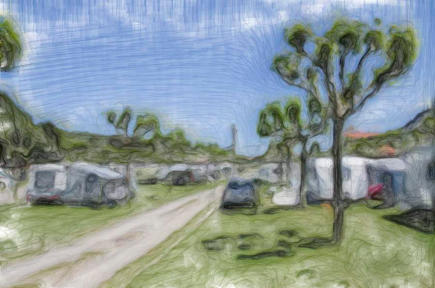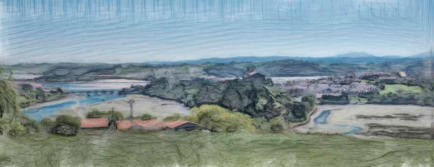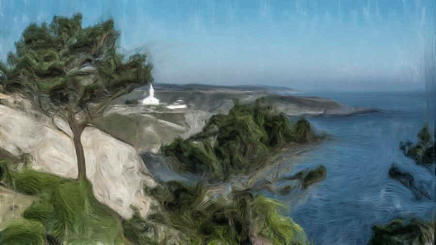May 18, Luarca - Castro Urdiales
The view from our camp was as stunning in early light as in late. Feeling a little urgency to have time for France and Switzerland, we opted to stay on the Autovia for most of the drive to Castro Urdiales. As yesterday, we are impressed with the highway. Massive viaducts span rivers and valleys providing a helicopter's eye view of forests, farms, and villages below, on occasion even providing glimpses of the sea. Tunnels, as long as 1.5 km, bored through mountains and then burst onto viaducts a hundred meters above the valley below. We detoured to the coast, past the estuary town of San Vicente de la Barquera. Two medieval stone bridges provided access to the town. Twenty eight stone arches sup- ported the 500 meter long Puenta de la Maza. Occupying an upland extending into the marsh and estuary, the church of Santa María de los Ángeles, built between the 13th and 16th centuries dominated the town and streets crowded with tourist oriented businesses. Back on the Autovia, we were disappointed to have been too early for lunch and to be leav- ing the coastal landscapes. We left the autovia and followed the Río Agüera to the coast, the last kilometre was a vast expanse of sand and along the road, an endless line of parked cars. We arrived at our campsite early in the after- noon. Another small pitch, no shade, commercial venture but fortunately it was early in the season and uncrowded. We discovered the reason for all the parked cars. A stones throw from our pitch was the most stunning sandy bay and beach sandwiched between rocky headlands. It was a magnificent spring day, warm sun and fresh sea breeze, sand stretched up the river, and blue water filled the bay. Had we not been in the campground, park- ing would have been impossible, but despite the mass of cars, the beach was so expansive as to appear nearly empty. After lunch and exploring the headland and beach, we drove into Castro Urdiales, the archetypal Spanish fishing village of my memory. I recognized the Gothic church of Santa María de la Asuncion, the Castillo de Santa Ana with its modern lighthouse, and bits of the old town from 40 years ago, but that was all. The idyllic Spanish seaside fishing village of my memory was gone. The widows in black shawls and scarves gossiping and old men in dark jackets and baggy pants with battered seamen's hats or fedoras smoking and arguing politics, the fisherman on the strand baiting and coiling their lines into trays that looked like Mexican sombreros, before carrying them on their heads to open boats beached on the strand and then dragging them to water and heading out for the evenings fishing were gone. I realized that it had never existed; It was a composite memory of highlight from that earlier trip and the fishermen coiling their lines a actually a memory from a Portuguese fishing village.. The harbour had been expanded for pleasure boats, the headlands crowded with summer homes and apartments, the waterfront turned into a large underground parking plaza and promenade. The old gothic church, stood in magnificent isolation, but although still active, was closed. The old castle was inaccessible, stone stairways blocked. The town streets still had their charms as a meeting place, but a cherished false memory was shattered and I returned to camp a little disappointed.May 19, Castro Urdiales - France
The drive from Islares in Spain to Mont-de- Marsan in France was uneventful. Although we would catch glimpses of stunning landscapes that would make us second guess our decision to leave Spain we remained resolute. But before leaving Spain we had one last chore to perform, we found a Carrefour (a Wal-Mart like general store) and stocked up on Spanish fried almonds and Manchego cheese before entering France. We probably would not have been aware of crossing the border had we not had Spanish signs when paying to leave the Spanish Autopista and French signs when paying to get on the French Autoroute.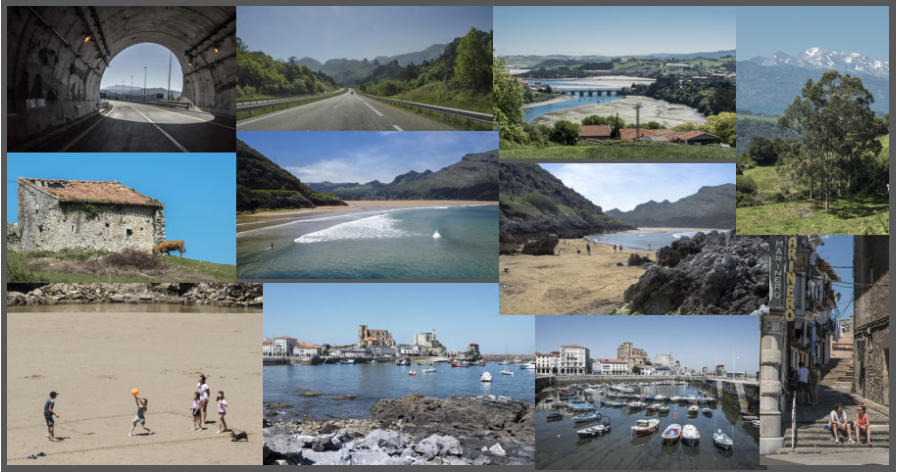


© David E. Moon, 2014 All rights reserved





by David E. Moon
A Sense of Place: Travel, Photography, and Photo-art


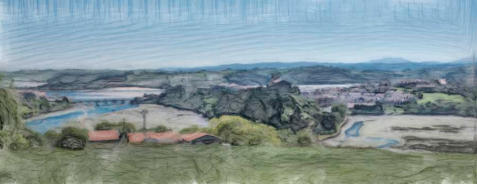

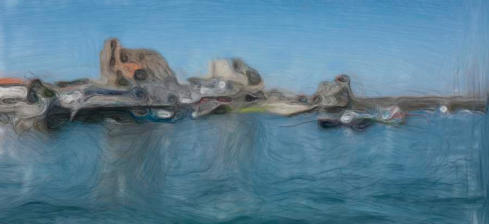
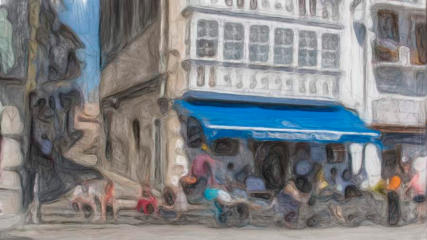

May 18, Luarca - Castro Urdiales
The view from our camp was as stunning in early light as in late. Feeling a little urgency to have time for France and Switzerland, we opted to stay on the Autovia for most of the drive to Castro Urdiales. As yesterday, we are impressed with the highway. Massive viaducts span rivers and valleys providing a helicopter's eye view of forests, farms, and villages below, on occasion even providing glimpses of the sea. Tunnels, as long as 1.5 km, bored through mountains and then burst onto viaducts a hundred meters above the valley below. We detoured to the coast, past the estuary town of San Vicente de la Barquera. Two medieval stone bridges provided access to the town. Twenty eight stone arches supported the 500 meter long Puenta de la Maza. Occupying an upland extend- ing into the marsh and estuary, the church of Santa María de los Ángeles, built between the 13th and 16th centuries dominated the town and streets crowded with tourist oriented businesses. Back on the Autovia, we were disappointed to have been too early for lunch and to be leav- ing the coastal landscapes. We left the autovia and followed the Río Agüera to the coast, the last kilometre was a vast expanse of sand and along the road, an endless line of parked cars. We arrived at our campsite early in the afternoon. Another small pitch, no shade, commercial venture but fortunately it was early in the season and uncrowded. We discovered the reason for all the parked cars. A stones throw from our pitch was the most stunning sandy bay and beach sand- wiched between rocky headlands. It was a magnificent spring day, warm sun and fresh sea breeze, sand stretched up the river, and blue water filled the bay. Had we not been in the campground, parking would have been impossible, but des- pite the mass of cars, the beach was so expansive as to appear nearly empty. After lunch and exploring the headland and beach, we drove into Castro Urdiales, the archetypal Spanish fishing village of my memory. I recognized the Gothic church of Santa María de la Asuncion, the Castillo de Santa Ana with its modern lighthouse, and bits of the old town from 40 years ago, but that was all. The idyllic Spanish seaside fishing village of my memory was gone. The widows in black shawls and scarves gossiping and old men in dark jackets and baggy pants with battered seamen's hats or fedoras smoking and arguing politics, the fisherman on the strand baiting and coiling their lines into trays that looked like Mexican sombreros, before carrying them on their heads to open boats beached on the strand and then dragging them to water and heading out for the evenings fishing were gone. I realized that it had never existed; It was a composite memory of highlight from that earlier trip and the fishermen coiling their lines a actually a memory from a Portuguese fishing village.. The harbour had been expanded for pleasure boats, the headlands crowded with summer homes and apartments, the waterfront turned into a large underground parking plaza and promenade. The old gothic church, stood in magnificent isolation, but although still active, was closed. The old castle was inaccessible, stone stairways blocked. The town streets still had their charms as a meeting place, but a cherished false memory was shattered and I returned to camp a little disappointed.May 19, Castro Urdiales - France
The drive from Islares in Spain to Mont-de- Marsan in France was uneventful. Although we would catch glimpses of stunning land- scapes that would make us second guess our decision to leave Spain we remained resolute. But before leaving Spain we had one last chore to perform, we found a Carrefour (a Wal-Mart like general store) and stocked up on Spanish fried almonds and Manchego cheese before enter- ing France. We probably would not have been aware of crossing the border had we not had Spanish signs when paying to leave the Span- ish Autopista and French signs when paying to get on the French Autoroute.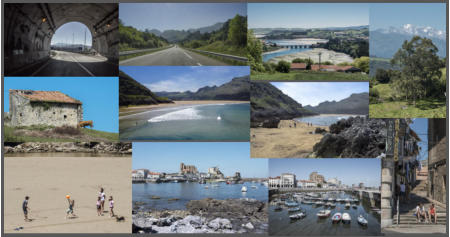


A Sense of Place: Travel, Photography, and Photo-art

© David E. Moon, 2014 All rights reserved




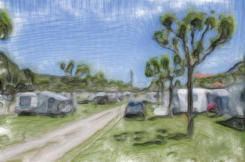
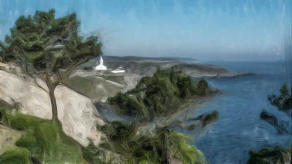

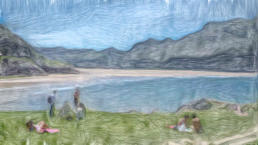






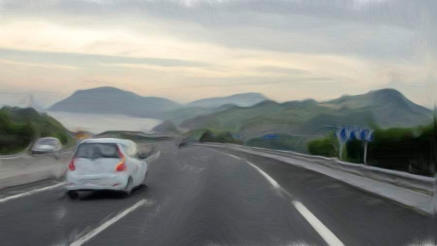
![Close [x]](index_htm_files/close.png)



